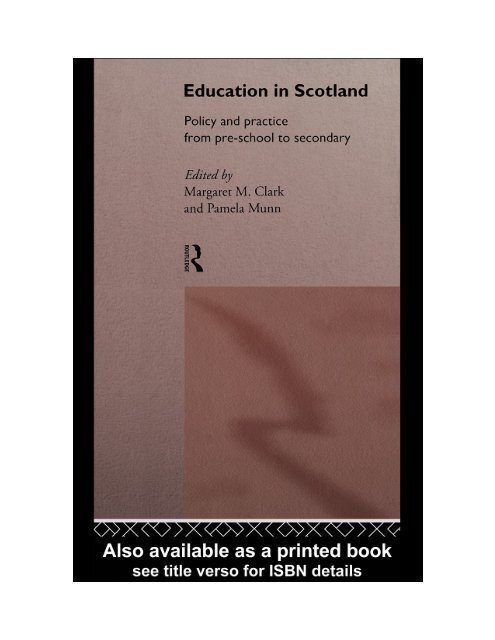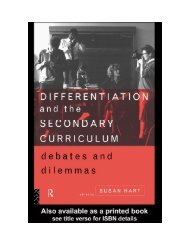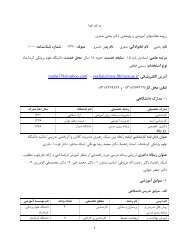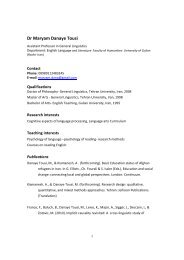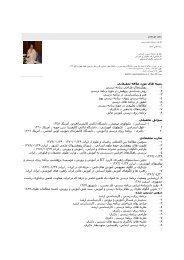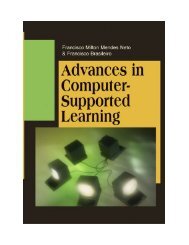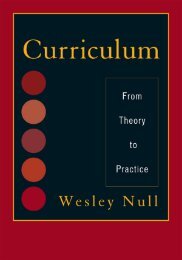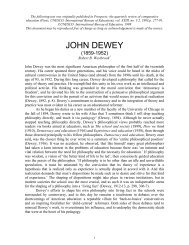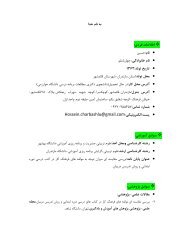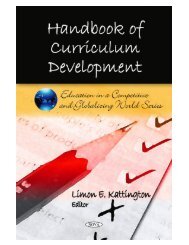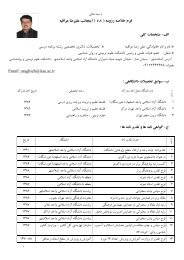Edited by Margaret M.Clark and Pamela Munn
Edited by Margaret M.Clark and Pamela Munn
Edited by Margaret M.Clark and Pamela Munn
Create successful ePaper yourself
Turn your PDF publications into a flip-book with our unique Google optimized e-Paper software.
EDUCATION IN SCOTLAND<br />
Education in Scotl<strong>and</strong> is markedly different from that in the rest of the United<br />
Kingdom—with a different curriculum, school boards to oversee school<br />
management <strong>and</strong> a General Teaching Council which has been in existence since<br />
1965.<br />
Whilst there are many examples of successful <strong>and</strong> innovative practice in<br />
Scotl<strong>and</strong>, the system is quite often not recognised as different <strong>by</strong> writers who talk<br />
about the United Kingdom education system as if it were one smooth whole.<br />
This book describes recent developments in both legislation <strong>and</strong> practice in<br />
Scotl<strong>and</strong>, drawing comparisons with the English system. Chapters cover<br />
administration <strong>and</strong> management, early years education provision, the curriculum<br />
in Scotl<strong>and</strong>, secondary education <strong>and</strong> special educational needs.<br />
is Emeritus Professor of Education at the University of<br />
Birmingham. is Professor of Curriculum Research at Moray<br />
House Institute of Education, Edinburgh.
EDUCATION IN<br />
SCOTLAND<br />
Policy <strong>and</strong> practice from pre-school to<br />
secondary<br />
<strong>Edited</strong> <strong>by</strong> <strong>Margaret</strong> M.<strong>Clark</strong> <strong>and</strong> <strong>Pamela</strong> <strong>Munn</strong><br />
London <strong>and</strong> New York
First published 1997<br />
<strong>by</strong> Routledge<br />
11 New Fetter Lane, London EC4P 4EE<br />
This edition published in the Taylor & Francis e-Library, 2005.<br />
“To purchase your own copy of this or any of Taylor & Francis or Routledge’s collection of<br />
thous<strong>and</strong>s of eBooks please go to www.eBookstore.t<strong>and</strong>f.co.uk.”<br />
Simultaneously published in the USA <strong>and</strong> Canada<br />
<strong>by</strong> Routledge<br />
29 West 35th Street, New York, NY 10001<br />
© 1997 <strong>Margaret</strong> M.<strong>Clark</strong>, <strong>Pamela</strong> <strong>Munn</strong><br />
<strong>and</strong> individual chapters to their authors<br />
All rights reserved. No part of this book may be reprinted or<br />
reproduced or utilized in any form or <strong>by</strong> any electronic,<br />
mechanical, or other means, now known or hereafter<br />
invented, including photocopying <strong>and</strong> recording, or in any<br />
information storage or retrieval system, without permission in<br />
writing from the publishers.<br />
British Library Cataloguing in Publication Data<br />
A catalogue record for this book is available from the British Library<br />
Library of Congress Cataloguing in Publication Data<br />
Education in Scotl<strong>and</strong>: policy <strong>and</strong> practice from pre-school to<br />
secondary/edited <strong>by</strong> <strong>Margaret</strong> M.<strong>Clark</strong> <strong>and</strong> <strong>Pamela</strong> <strong>Munn</strong>.<br />
p. cm.<br />
Includes index.<br />
ISBN 0-415-15835-4 (Print Edition)<br />
ISBN0-415-15836-2 (pbk.)<br />
1. Education-Scotl<strong>and</strong>-Evaluation. 2. Education <strong>and</strong> state-<br />
-Scotl<strong>and</strong>. 3. School management <strong>and</strong> organization-Scotl<strong>and</strong>.<br />
I.<strong>Clark</strong>, <strong>Margaret</strong> MacDonald. II. <strong>Munn</strong>, <strong>Pamela</strong>.<br />
LA652.E25 1997<br />
370 .9411–dc21 97–14247<br />
CIP<br />
ISBN 0-203-97484-0 Master e-book ISBN
CONTENTS<br />
List of contributors<br />
Preface<br />
Acknowledgements<br />
Abbreviations<br />
vi<br />
ix<br />
x<br />
xi<br />
1 EDUCATION IN SCOTLAND: SETTING THE SCENE<br />
<strong>Margaret</strong> M.<strong>Clark</strong><br />
2 THE UNDER-FIVES: FROM ‘PRE-SCHOOL EDUCATION’ TO<br />
‘EARLY YEARS SERVICES’<br />
Joyce Watt<br />
3 DEVELOPMENTS IN PRIMARY EDUCATION IN SCOTLAND<br />
<strong>Margaret</strong> M.<strong>Clark</strong><br />
4 THE STATUTORY YEARS OF SECONDARY EDUCATION:<br />
CHANGE AND PROGRESS<br />
Brian Boyd<br />
5 UPPER-SECONDARY EDUCATION<br />
David Raffe<br />
6 SPECIAL EDUCATIONAL PROVISION<br />
Alison Closs<br />
7 THE TEACHING PROFESSION: ITS QUALIFICATIONS AND<br />
STATUS<br />
<strong>Margaret</strong> M.<strong>Clark</strong><br />
8 STANDARDS AND QUALITY<br />
<strong>Pamela</strong> <strong>Munn</strong><br />
9 DEVOLVED MANAGEMENT OF SCHOOLS<br />
<strong>Pamela</strong> <strong>Munn</strong><br />
10 POLICY-MAKING IN SCOTTISH EDUCATION: A CASE OF<br />
PRAGMATIC NATIONALISM<br />
Lindsay Paterson<br />
1<br />
15<br />
28<br />
42<br />
54<br />
65<br />
79<br />
93<br />
101<br />
111
v<br />
11 HOW SCOTTISH is THE SCOTTISH CURRICULUM: AND<br />
DOES IT MATTER<br />
Cameron Harrison<br />
12 FUTURE DIRECTIONS<br />
<strong>Pamela</strong> <strong>Munn</strong><br />
125<br />
136<br />
Useful Addresses 144<br />
Index 145
CONTRIBUTORS<br />
<br />
is Emeritus Professor of Education at the University of<br />
Birmingham. She was educated in Scotl<strong>and</strong> <strong>and</strong> has taught at primary school,<br />
college of education <strong>and</strong> universities in Scotl<strong>and</strong>. After her move to Engl<strong>and</strong><br />
in 1979 as Professor of Education at the University of Birmingham she kept in<br />
touch with developments in Scotl<strong>and</strong>, for several years as Assessor in<br />
Education for the University of Strathclyde. She has undertaken research into<br />
many aspects of education, funded <strong>by</strong> the Scottish Education Department <strong>and</strong><br />
the Department of Education <strong>and</strong> Science, <strong>and</strong> was personally commissioned<br />
<strong>by</strong> the Secretary of State for Education to undertake an evaluation of research<br />
of relevance to the education of children under five. In 1988 she was awarded<br />
the Scottish Council for Research in Education’s Fellowship for her<br />
distinguished contribution to educational research. Her publications include<br />
the internationally quoted Young Fluent Readers (Heinemann, 1976) <strong>and</strong><br />
Children Under Five: Educational Research <strong>and</strong> Evidence (Gordon <strong>and</strong><br />
Breach, 1988).<br />
is Professor of Curriculum Research at Moray House Institute<br />
of Education, Edinburgh. Her previous posts include those of Depute Director<br />
of the Scottish Council for Research in Education <strong>and</strong> a lectureship at the<br />
University of York. She is a researcher of over fifteen years’ st<strong>and</strong>ing,<br />
attracting substantial funds from a range of research bodies <strong>and</strong> charities. She<br />
has published widely on school discipline <strong>and</strong> on school governance. She was<br />
awarded the SCRE silver medal for the most promising young researcher in<br />
1982. Her most recent books are Parents <strong>and</strong> Schools: Customers, Managers<br />
or Partners (Routledge, 1993) <strong>and</strong> (as co-author) two companion volumes on<br />
school discipline: Effective Discipline in Secondary Schools <strong>and</strong> Classrooms<br />
<strong>and</strong> Effective Discipline in Primary Schools <strong>and</strong> Classrooms (Paul Chapman,<br />
1992). She sits on the editorial boards of a number of national <strong>and</strong><br />
international journals.<br />
<br />
is Associate Director of Quality in Education at the University of<br />
Strathclyde. He has taught in a junior secondary school, been headteacher of a
comprehensive school <strong>and</strong> was Chief Adviser in Strathclyde Region. He has<br />
written extensively on Scottish education <strong>and</strong> is currently involved in school<br />
improvement research.<br />
is Emeritus Professor of Education at the University of<br />
Birmingham. She was educated in Scotl<strong>and</strong> <strong>and</strong> has taught at primary school,<br />
college of education <strong>and</strong> universities in Scotl<strong>and</strong>. She has undertaken research<br />
into many aspects of education, funded <strong>by</strong> the Scottish Education Department<br />
<strong>and</strong> the Department of Education <strong>and</strong> Science.<br />
is Lecturer in Special Needs/Support for Learning, Moray House<br />
Institute of Education, Edinburgh. Her interests in teacher education <strong>and</strong><br />
research include the links between disadvantage, cultural differences,<br />
difficulties in learning <strong>and</strong> teacher attitudes. Current research concerns the<br />
education of children with serious medical conditions, <strong>and</strong> Romany <strong>and</strong><br />
refugee children.<br />
is the Chief Executive of the Scottish Consultative Council<br />
on the Curriculum, a post he has held since 1991. The Council is the principal<br />
advisory body on the school curriculum for 3–18-year-olds. He is associated<br />
with a number of academic institutes within Scotl<strong>and</strong> <strong>and</strong> has written<br />
extensively on the curriculum <strong>and</strong> on managing change within education<br />
systems.<br />
is Professor of Curriculum Research at Moray House Institute<br />
of Education, Edinburgh. Her previous posts include those of Depute Director<br />
of the Scottish Council for Research in Education <strong>and</strong> a lectureship at the<br />
University of York. She is a researcher of over fifteen years’ st<strong>and</strong>ing,<br />
attracting substantial funds from a range of research bodies <strong>and</strong> charities. She<br />
has published widely on school discipline <strong>and</strong> on school governance.<br />
is Professor of Educational Policy at Moray House Institute<br />
of Education, Edinburgh. He has worked at the Centre for Educational<br />
Sociology at the University of Edinburgh <strong>and</strong> has published on many aspects<br />
of the sociology of education—in particular on the effects of social<br />
disadvantage <strong>and</strong> on the expansion of higher education, <strong>and</strong> on Scottish<br />
politics <strong>and</strong> culture. His most recent books are Politics <strong>and</strong> Society in Scotl<strong>and</strong>,<br />
with Alice Brown <strong>and</strong> David McCrone (Macmillan, 1996) <strong>and</strong> The Autonomy<br />
of Modern Scotl<strong>and</strong> (EUP, 1994). He is vice-convenor of the Unit for the<br />
Study of Government in Scotl<strong>and</strong>, <strong>and</strong> edits its quarterly journal, Scottish<br />
Affairs.<br />
is Professor of Sociology of Education at the University of<br />
Edinburgh. He directs the Centre for Educational Sociology <strong>and</strong> co-directs the<br />
Institute for the Study of Education <strong>and</strong> Society. His research interests include<br />
secondary <strong>and</strong> post-secondary education <strong>and</strong> the labour market, with particular<br />
emphasis on the post-compulsory education <strong>and</strong> training systems of Scotl<strong>and</strong><br />
<strong>and</strong> other countries.<br />
vii
viii<br />
is Reader in Education at the University of Aberdeen. She has<br />
wide experience of early education <strong>and</strong> of educational disadvantage in<br />
Scotl<strong>and</strong> as a primary teacher, lecturer in teacher education <strong>and</strong> researcher.<br />
She has published widely <strong>and</strong> has contributed to national <strong>and</strong> international<br />
conferences in both fields for many years.
PREFACE<br />
People use the term ‘British education’ when what they really mean is English<br />
education. The Scots have a long <strong>and</strong> proud tradition of a distinctive education<br />
system. This book describes the key features of Scottish education <strong>and</strong> highlights<br />
the main differences from the English system. It is a must for those interested in<br />
the different ways in which schools are organised, the curriculum is arranged <strong>and</strong><br />
teachers are trained. It is especially pertinent at a time when many countries are<br />
reviewing their curricula <strong>and</strong> st<strong>and</strong>ards.<br />
The book covers the stages of education in Scotl<strong>and</strong> from pre-school to<br />
secondary. It contains chapters written <strong>by</strong> acknowledged experts in their fields. It<br />
reviews provision at pre-five, the 5–14 programme, Scotl<strong>and</strong>’s rather different<br />
version of a national curriculum, the 14–16 curriculum <strong>and</strong> the distinctive<br />
approach taken to upper-secondary education called Higher Still. It raises<br />
questions about how Scottish the curriculum is <strong>and</strong> speculates about whether<br />
such distinctions as there are will continue. There are also chapters on special<br />
education <strong>and</strong> on the education of teachers, with particular reference to the role<br />
<strong>and</strong> function of the General Teaching Council. The book considers the policy<br />
context in which education operates <strong>and</strong> discusses the devolved management of<br />
schools, Scottish style, as well as the scope for a separate education policy.<br />
This is the first major book for over twenty years giving a comprehensive<br />
overview of Scottish education. It will help readers answer the question of whether<br />
education in Scotl<strong>and</strong> really is superior to that elsewhere in the United Kingdom<br />
<strong>and</strong>, if it is, suggest the possible reasons for this. This book is a must for anyone<br />
interested in st<strong>and</strong>ards <strong>and</strong> quality <strong>and</strong> in attempts to ensure parity of esteem<br />
between vocational <strong>and</strong> academic courses, <strong>and</strong> for students of public policy.
ACKNOWLEDGEMENTS<br />
The editors wish to express their thanks to all the many colleagues <strong>and</strong> friends<br />
who have read <strong>and</strong> commented on the proposal for the book <strong>and</strong> drafts of the<br />
various chapters. We are also grateful to all those individuals <strong>and</strong> departments in<br />
central <strong>and</strong> local government who have supplied us with information. We hope<br />
they will underst<strong>and</strong> that we are no less grateful for not mentioning them <strong>by</strong><br />
name. We are particularly grateful to Lesley Scullion, who coped with<br />
successive drafts <strong>and</strong> last-minute alterations efficiently <strong>and</strong> with good humour.
ABBREVIATIONS<br />
COSLA<br />
CRDU<br />
CSE<br />
CSYS<br />
DES<br />
DfEE<br />
EIS<br />
GTC<br />
HMI<br />
NCVQ<br />
OFSTED<br />
QNCA<br />
SCAA<br />
SCCC<br />
SCE<br />
SCET<br />
SCOTVEC<br />
SCRE<br />
SEB<br />
SED<br />
SHEFC<br />
SOED<br />
SOEID<br />
SPPA<br />
SPTC<br />
Convention of Scottish Local Authorities<br />
Children’s Rights Development Unit<br />
Certificate in Secondary Education<br />
Certificate of Sixth Form Studies<br />
Department of Education <strong>and</strong> Science<br />
Department for Education <strong>and</strong> Employment<br />
Educational Institute of Scotl<strong>and</strong><br />
General Teaching Council for Scotl<strong>and</strong><br />
Her Majesty’s Inspectorate<br />
National Council for Vocational Qualifications<br />
Office for St<strong>and</strong>ards in Education<br />
Qualifications <strong>and</strong> National Curriculum Authority (replaces<br />
SCAA <strong>and</strong> NCVQ)<br />
School Curriculum <strong>and</strong> Assessment Authority<br />
Scottish Consultative Council on the Curriculum<br />
Scottish Certificate of Education<br />
Scottish Council for Educational Technology<br />
Scottish Vocational Education Council<br />
Scottish Council for Research in Education<br />
Scottish Examination Board<br />
Scottish Education Department<br />
Scottish Higher Education Funding Council<br />
Scottish Office Education Department<br />
Scottish Office Education <strong>and</strong> Industry Department<br />
Scottish Pre-School Playgroups Association<br />
Scottish Parent Teacher Council
xii<br />
SQA Scottish Qualifications Authority (replaces SEB <strong>and</strong><br />
SCOTVEC)<br />
SRC<br />
Strathclyde Regional Council<br />
SSBA Scottish School Board Association<br />
TVEI Technical <strong>and</strong> Vocational Education Initiative
1<br />
EDUCATION IN SCOTLAND<br />
Setting the scene<br />
<strong>Margaret</strong> M.<strong>Clark</strong><br />
In recent years there have been major changes in education in the United<br />
Kingdom, in the curriculum <strong>and</strong> in the assessment of achievement, in<br />
management <strong>and</strong> inspection of schools <strong>and</strong> in the education of teachers. The<br />
impression is often given that developments in Scotl<strong>and</strong> differ little from those<br />
elsewhere in the United Kingdom; that is an erroneous impression which this<br />
book should dispel. The book is aimed at a wide readership overseas as well as in<br />
the United Kingdom. As will be seen, many of the issues being confronted in<br />
Scotl<strong>and</strong> today, <strong>and</strong> the proposed solutions, have relevance to educationists in<br />
many countries.<br />
This chapter provides readers with a brief outline of education in Scotl<strong>and</strong>.<br />
Where the organisation <strong>and</strong> developments differ fundamentally from those in<br />
Engl<strong>and</strong>, this is indicated in italics. Brief reference is made to issues considered<br />
in the following chapters; there full reference lists are to be found. Where<br />
developments are relevant to more than one chapter, the context is set out here.<br />
<br />
In 1997, Scotl<strong>and</strong>, with a population of about 5 million, is part of the United<br />
Kingdom (which also includes Engl<strong>and</strong>, Wales <strong>and</strong> Northern Irel<strong>and</strong>), with a<br />
total population of about 58 million. The political structures in the United<br />
Kingdom in the twentieth century may be a puzzle to readers from other countries<br />
—particularly the claim that there is a distinctive system of governing Scotl<strong>and</strong>,<br />
since there has been no separate legislature in modern times. The United<br />
Kingdom Parliament is in London, <strong>and</strong> only a minority of Members of<br />
Parliament from Scotl<strong>and</strong> belonged to the government which was in power for<br />
eighteen years to 1997 (at the General Election in 1992 only 11 of 72 seats in<br />
Scotl<strong>and</strong> were won <strong>by</strong> Conservatives, <strong>and</strong> at the General Election in 1997 there<br />
were no Conservative MPs returned from Scotl<strong>and</strong>). Yet, even under a<br />
Conservative government that has been described as hostile to Scottish<br />
distinctiveness many distinctive features survived, particularly with regard to<br />
education <strong>and</strong> the legal system. There have, however, been increasing strains<br />
since the late 1970s (see Brown, McCrone <strong>and</strong> Paterson 1996). Lindsay Paterson
2 EDUCATION IN SCOTLAND<br />
discusses policy-making in Scottish education in Chapter 10. The ‘Scottishness’<br />
of the curriculum in Scotl<strong>and</strong> is considered <strong>by</strong> Cameron Harrison in Chapter 11.<br />
Although for some aspects there are separate Acts of Parliament for Scotl<strong>and</strong>,<br />
they must be passed <strong>by</strong> the Parliament in Westminster. Prior to the General<br />
Election which took place in May 1997, there was debate as to whether <strong>and</strong> to<br />
what extent Scottish affairs should become independent of Engl<strong>and</strong>. With the<br />
advent of a Labour government, this debate is now heightened. Autonomy could<br />
entail complete state independence, probably inside the European Union, thus<br />
putting Scotl<strong>and</strong> in a position analogous to that of Denmark <strong>and</strong> Sweden; or it<br />
could involve the devolution of some legislative powers <strong>and</strong> responsibilities from<br />
Westminster to a directly elected Scottish Parliament. Whatever the outcome, the<br />
issues discussed in this book will still be pertinent, <strong>and</strong> the distinctiveness of<br />
Scottish education is likely to remain. In Chapter 12 <strong>Pamela</strong> <strong>Munn</strong> considers this<br />
<strong>and</strong> other issues concerning the future of Scottish education.<br />
Two important background features are of relevance to education in Scotl<strong>and</strong>.<br />
First, Scotl<strong>and</strong> is the most sparsely populated part of the United Kingdom, <strong>and</strong><br />
second, there are high levels of poverty in some areas. In 1995 about 20 per cent<br />
of the school population were entitled to free school meals; this varied from<br />
about 6 per cent in the Borders Region to about 40 per cent in the City of<br />
Glasgow. In Glasgow in 1993, one in three children lived in households<br />
dependent on income support <strong>and</strong> one in two of all primary-school children<br />
received clothing grants. The focus for many of the early interventions into<br />
educational disadvantage was the densely populated urban areas, which is not<br />
surprising when one considers the level of deprivation in some urban areas.<br />
However, since the early 1990s a range of national research <strong>and</strong> development<br />
projects have been initiated in rural areas. In many cases these have been linked<br />
with economic regeneration (Nisbet <strong>and</strong> Watt 1993).<br />
<br />
<br />
Education in Scotl<strong>and</strong> has been organised separately from that in Engl<strong>and</strong> <strong>and</strong><br />
Wales since the Union of 1707, <strong>and</strong> there are separate Acts of Parliament<br />
governing most aspects of Scottish education. The school system was initially<br />
developed <strong>by</strong> the churches <strong>and</strong> formally came under the Scotch (later Scottish)<br />
Education Department from 1872. For more than a decade after that, resources<br />
were directed towards the provision of an efficient system of elementary<br />
education; very few children went to secondary school. Between 1872 <strong>and</strong> 1885<br />
one education department covered the whole of the United Kingdom. At that<br />
time, the governing bodies which had the greatest impact on schooling, however,<br />
were the HMI (which have always been based in Scotl<strong>and</strong>) <strong>and</strong> the school boards<br />
(or their predecessors). In 1885, Parliament established an independent Scotch<br />
Education Department, initially in London. The Scottish Education Department<br />
(SED), subsequently based in Edinburgh, has been renamed several times, first
EDUCATION IN SCOTLAND: SETTING THE SCENE 3<br />
as the Scottish Office Education Department (SOED); currently it is the Scottish<br />
Office Education <strong>and</strong> Industry Department (SOEID). The Scottish Office, which<br />
is in Edinburgh, has a ministerial team headed <strong>by</strong> the Secretary of State for<br />
Scotl<strong>and</strong>, who is a member of the Cabinet. In the Scottish Office there is an<br />
Education <strong>and</strong> Industry Department headed <strong>by</strong> its own minister.<br />
The Secretary of State for Education is the Cabinet minister<br />
responsible for education in Engl<strong>and</strong>, <strong>and</strong> the relevant department is<br />
currently the Department for Education <strong>and</strong> Employment. Parallel<br />
changes in the name of the responsible department have taken place<br />
in Engl<strong>and</strong>, with the Department of Education <strong>and</strong> Science (DES)<br />
changing to DfE <strong>and</strong> now DfEE.<br />
Between 1975 <strong>and</strong> 1996 there were two tiers of local government in Scotl<strong>and</strong>,<br />
Regions <strong>and</strong> districts, except for three isl<strong>and</strong> all-purpose authorities. Education<br />
was the responsibility of the 9 Regions <strong>and</strong> 3 isl<strong>and</strong> authorities. Strathclyde<br />
Region both covered a very large <strong>and</strong> diverse area geographically <strong>and</strong> included<br />
about half the population. In 1996, 29 single-tier councils replaced the 9 former<br />
Regions <strong>and</strong> 53 districts. The 3 small all-purpose isl<strong>and</strong> councils (Orkney,<br />
Shetl<strong>and</strong> <strong>and</strong> Western Isles) have remained in place. Some of the fears with<br />
regard to education which dominated the parliamentary passage of the legislation<br />
have not been realised, since all the councils have appointed directors of<br />
education <strong>and</strong> education committees although they were not statutorily obliged to<br />
do so. Some of the committees have other responsibilities, <strong>and</strong> one has subsumed<br />
education within a children’s committee. More varied approaches <strong>and</strong> structures<br />
are likely to emerge with 32 smaller education authorities; it is too early to assess<br />
the impact of the change. However, virtually all councils have given high priority<br />
to pre-fives <strong>and</strong> special needs. Stress is also being placed on quality measures<br />
<strong>and</strong> on projects to improve literacy. The major problem for the new councils is<br />
the budgetary restrictions under which they are operating. (See TES Scotl<strong>and</strong><br />
1996 for a leaflet setting out the details of the new councils, their education<br />
officials <strong>and</strong> a summary of their plans.)<br />
The structure described above applied to most sections of Scottish education,<br />
with two exceptions, the universities which were answerable ultimately to<br />
government departments in London, <strong>and</strong> certain types of colleges run directly <strong>by</strong><br />
the Scottish Education Department. These exceptions have now ended: all<br />
institutions of higher education have been directly overseen since 1993 <strong>by</strong> the<br />
Scottish Higher Education Funding Council, <strong>and</strong> the control of the vocational<br />
colleges of further education was transferred from local government to the<br />
Scottish Office.
4 EDUCATION IN SCOTLAND<br />
<br />
The publication of official statistics on Scottish education dates back well over a<br />
hundred years. The information for this section has been taken from the most<br />
recent information on numbers of schools, teachers <strong>and</strong> pupils in the first of a<br />
new series of publications, Scottish Education Statistics (SOEID 1996). Similar<br />
documents are published for Engl<strong>and</strong>, Wales <strong>and</strong> Northern Irel<strong>and</strong>. As the<br />
statistics cover the years 1990–1 to 1994–5 the breakdown of information is in<br />
terms of the former education authorities.<br />
Schools in Scotl<strong>and</strong> fall into four main groups:<br />
1 Education authority schools are financed partly <strong>by</strong> central government <strong>and</strong><br />
partly <strong>by</strong> local taxation. These are under the management of local<br />
authorities, responsible for the allocation of funding. School boards,<br />
consisting of parents <strong>and</strong> teachers co-opted from the local community, with<br />
parents in the majority, have been established in about three-quarters of<br />
education authority schools.<br />
2 Two schools (at June 1996) had self-governing status, that is, were funded<br />
direct from central government.<br />
3 Independent schools are run <strong>by</strong> the proprietors without any aid from public<br />
funds. Some of these schools participate in the assisted places scheme which<br />
provides financial assistance for secondary pupils who would otherwise not<br />
be able to attend an independent school (these places the Labour<br />
government plans to phase out).<br />
4 A small number of grant-aided schools, mainly in the special sector, are run<br />
<strong>by</strong> boards of managers who receive grants from central government.<br />
Nursery schools provide education on a full-or part-time basis for children below<br />
compulsory school age. Children enter primary school at the beginning of the<br />
school year in August if they will be five years of age <strong>by</strong> the end of February of<br />
that school year. Primary schools have children aged from 5 to 12 years of age<br />
(P1 to P7); secondary schools are for pupils from 12 to 16–18 depending on<br />
when the individual pupils choose to leave school (S1 to S6).<br />
Scotl<strong>and</strong> has no equivalent of the Sixth Form College or Tertiary<br />
College.<br />
The following is the information on schools/departments in Scotl<strong>and</strong> in 1994–5,<br />
with the numbers of pupils in each type of school in brackets:<br />
Schools/Departments<br />
Pupils<br />
Education authority schools<br />
Nursery 784 (49,760)
EDUCATION IN SCOTLAND: SETTING THE SCENE 5<br />
Primary 2,336 (438,010)<br />
Secondary 405 (314,907)<br />
Special* 318 (8,712)<br />
Other<br />
Grant-aided schools† 9 (1,472)<br />
Independent schools 116 (32,579)<br />
* The figure for special schools in SOEID 1996 refers to both schools <strong>and</strong> departments<br />
based in schools outside the special sector. I underst<strong>and</strong> that the information on<br />
special education will in future not be presented in that form as pupils who<br />
attend special departments are otherwise integrated into the school curriculum.<br />
As stated in Chapter 6, there were 201 special schools in 1994–5 (see that<br />
chapter for further information on special education).<br />
† The majority of the grant-aided schools joined the independent sector in 1985.<br />
The total school population in Scotl<strong>and</strong> in 1994–5 was 845,440, of whom<br />
about 96 per cent were in local authority schools; most of the remaining 4 per<br />
cent attended independent schools.<br />
In contrast, in Engl<strong>and</strong> in 1996 according to DfEE 1 in 5 state<br />
secondary-school pupils was being educated in a grant-maintained<br />
school. There are 1,100 GM schools, primary, secondary <strong>and</strong><br />
special. Since 1994 the Funding Agency for Schools has been<br />
responsible for the calculation <strong>and</strong> payment of grants to GM<br />
schools.<br />
The numbers of (full-time equivalent) teachers in schools in Scotl<strong>and</strong> were as<br />
follows in 1994–5:<br />
Education authority schools 50,014<br />
Grant-aided schools 162<br />
Independent schools 3,207<br />
Pupil-teacher ratios are given in the statistics for different types of school <strong>and</strong> for<br />
each education authority. It would not be helpful to quote these, however, as<br />
averages are particularly misleading in a country like Scotl<strong>and</strong> where there are<br />
many small rural schools; indeed, in some education authorities most of the<br />
primary schools have fewer than 100 pupils on roll <strong>and</strong> many classes are composite<br />
classes. There are over one hundred primary schools with 20 pupils or under. In<br />
1994 more than half the primary schools in Scotl<strong>and</strong> had 200 pupils or fewer on<br />
roll, <strong>and</strong> 64 of 406 secondary schools had 400 or fewer on roll.<br />
The size of the school roll is an important factor in the budgeting costs per<br />
pupil: in general, the smaller the school, the higher the cost per pupil. The
6 EDUCATION IN SCOTLAND<br />
national average cost for secondary-school pupils in Scotl<strong>and</strong> remains<br />
significantly higher than that for primary pupils. In 1995–6 primary schools with<br />
rolls above 300 had budgeted running costs per pupil in the range £1,000-£2,000.<br />
Most secondary schools with rolls above 800 had budgeted running costs per<br />
pupil in the range £2,000-£3,000; however, a school with a roll of 300 might<br />
have budgeted running costs per pupil around 50 per cent higher than a school<br />
with a roll of 800 (see HMI 1996a).<br />
No education statistics are available from the Scottish Office for pupils whose<br />
mother tongue is not English, or who are from ethnic minorities. It is clear from<br />
the available census figures, however, that the picture in Scotl<strong>and</strong> is very<br />
different from that in Engl<strong>and</strong>.<br />
According to the 1991 census only 1.4 per cent of the population in Scotl<strong>and</strong><br />
over three years of age speak, read or write Gaelic. The largest concentrations<br />
are in the Western Isles, Highl<strong>and</strong> <strong>and</strong> Strathclyde Regions. However, over the<br />
past ten years there has been support from the Scottish Office for the teaching of<br />
Gaelic <strong>and</strong> through the medium of Gaelic (see Chapter 3).<br />
According to the 1991 census, Scotl<strong>and</strong>’s population was about five million,<br />
98.7 per cent of whom were white. Thus only 1.3 per cent of the population were<br />
from ethnic minorities, of whom the vast majority were of Pakistani or Indian<br />
origin; the second largest group was Chinese. The majority of the non-white<br />
population are concentrated in Glasgow <strong>and</strong> Edinburgh.<br />
In Engl<strong>and</strong> in 1991 6.2 per cent of the population were from ethnic<br />
minorities.<br />
<br />
While Scotl<strong>and</strong> has its own policy-making procedures for the care <strong>and</strong> education<br />
of its under-fives, the organisational framework is similar to that of the rest of<br />
the United Kingdom, <strong>and</strong> like the rest of the country Scotl<strong>and</strong> is one of the most<br />
poorly served parts of the European Union in terms of under-fives provision. The<br />
roots of early years education in Scotl<strong>and</strong> lie in poverty <strong>and</strong> educational<br />
disadvantage.<br />
Lack of funding has stemmed partly from the fact that services for under-fives<br />
have been outside the statutory education service <strong>and</strong> therefore frequently<br />
subjected to cuts. Furthermore, fragmentation of services has been a consequence<br />
of the fact that responsibility for pre-fives services has been divided at both<br />
national <strong>and</strong> local level, between education <strong>and</strong> social work departments. An<br />
exception was the former Strathclyde Region, which made a pioneering attempt<br />
to bring the services together under its education department. The recently<br />
established Stirling council has taken the radical step of establishing a children’s<br />
committee which aims to integrate all services in pre-fives education with<br />
services in social work, play <strong>and</strong> family support. Indeed, committee structures<br />
<strong>and</strong> the management of early years services are now under active discussion <strong>by</strong> all
EDUCATION IN SCOTLAND: SETTING THE SCENE 7<br />
the new unitary authorities, <strong>and</strong> new patterns are emerging. Thus, attempts are<br />
being made to increase the level of provision for pre-fives; to get rid of the false<br />
distinctions between ‘education’ <strong>and</strong> ‘care’; to increase the partnership between<br />
the public, voluntary <strong>and</strong> private sectors; <strong>and</strong> to introduce quality assurance<br />
procedures as for other public-sector services.<br />
In Scotl<strong>and</strong>, as in Engl<strong>and</strong>, the Conservative government introduced a pilot<br />
voucher scheme to enable parents of four-year-olds to purchase a part-time place<br />
in any approved under-fives group. It is unlikely that the proposed extension of<br />
this scheme, which has been highly controversial, will survive the recent change<br />
of government. Developments in the care <strong>and</strong> education of under-fives is<br />
discussed <strong>by</strong> Joyce Watt in Chapter 2.<br />
<br />
<br />
There have been major developments in the curriculum <strong>and</strong> in assessment in<br />
Scotl<strong>and</strong>, as in Engl<strong>and</strong> <strong>and</strong> Wales, over the past ten years; however, the changes<br />
have increased rather than reduced the differences between education in Scotl<strong>and</strong><br />
<strong>and</strong> that in Engl<strong>and</strong> <strong>and</strong> Wales.<br />
The Scottish Consultative Council on the Curriculum (SCCC) is the principal<br />
advisory body to the Secretary of State for Scotl<strong>and</strong> on all matters relating to the<br />
curriculum for 3–18-year-olds. It keeps the Scottish school curriculum under<br />
review; issues guidance on the curriculum to local authorities <strong>and</strong> to schools; <strong>and</strong><br />
carries out programmes of curriculum development, consulting with interested<br />
groups <strong>and</strong> individuals. Its recent publication Teaching for Effective Learning,<br />
which was the subject of widespread consultation, has met with an enthusiastic<br />
response (SCCC 1996). SCCC has launched its largest ever consultation,<br />
including businesses, unions, cultural agencies, the churches, political parties <strong>and</strong><br />
the media, on the place of Scottish culture in schools. It has extensive international<br />
links, <strong>and</strong> for the past three years has provided the Secretariat for CIDREE<br />
(Consortium of Institutions for Development <strong>and</strong> Research in Education in<br />
Europe); this will continue for a further three years.<br />
There is not a national curriculum in Scotl<strong>and</strong>. The national guidelines in the<br />
5–14 Programme developed between 1987 <strong>and</strong> 1993 are based on the reports of<br />
working parties of professionals closely involved in work in the schools. Unlike<br />
the national curriculum in Engl<strong>and</strong> <strong>and</strong> Wales, they do not represent a sharp<br />
change from previous policy. The guidelines lay emphasis on balance, breadth<br />
<strong>and</strong> continuity in children’s learning. Thus they cover the seven years of primary<br />
education, <strong>and</strong> the first two years of secondary education. An outline of the<br />
programme is to be found in The Structure <strong>and</strong> Balance of the Curriculum 5–14<br />
(SOED 1993), <strong>and</strong> further details of its implications for primary education are to<br />
be found in Chapter 3.<br />
The implementation of the guidelines for English <strong>and</strong> mathematics in primary<br />
schools is well under way. The target is for all the guidelines to be implemented
8 EDUCATION IN SCOTLAND<br />
<strong>by</strong> 1998–9. Assessment <strong>and</strong> reporting form an integral part of the programme,<br />
with emphasis on teacher assessment, <strong>and</strong> materials for diagnostic assessment in<br />
English, mathematics <strong>and</strong> science are already available. National tests in English<br />
<strong>and</strong> mathematics which were initially to have been administered in P4 <strong>and</strong> P7 are<br />
now seen as a support for teacher assessment, administered at the teachers’<br />
discretion, not at specific points in a child’s schooling. The tests are prepared <strong>by</strong><br />
the 5–14 Assessment Unit in the Scottish Examination Board, which issues a<br />
catalogue from which teachers select tests. No league tables are prepared on the<br />
basis of the national tests; indeed, it would not be possible to do so in view of the<br />
way they are constructed <strong>and</strong> administered. The results are communicated only<br />
to the parents of the individual pupils.<br />
Disappointment has been expressed at the limited influence of the guidelines<br />
on the first two years of secondary education, where mixed ability teaching<br />
predominates, <strong>and</strong> at st<strong>and</strong>ards in these years, including those revealed in the<br />
recently published international survey. Under discussion are the possibility of<br />
‘setting’ in the early years of secondary schooling <strong>and</strong> proposals that there<br />
should be national testing during that stage of secondary education, which some<br />
feel would cut across the aims of the national guidelines for 5–14 with their<br />
emphasis on continuity from primary to secondary education. Neither the issue<br />
of ‘setting’ versus mixed ability teaching nor that of national testing in S1 or S2<br />
has so far been resolved.<br />
There was active promotion of comprehensive education in Scotl<strong>and</strong> in the<br />
late 1960s <strong>and</strong> increasing numbers of pupils stayed on in school beyond the<br />
statutory leaving age, which in 1972 was raised to sixteen. There are no selective<br />
public (maintained) schools in Scotl<strong>and</strong>. In the 1970s two parallel committees<br />
were established: the Dunning committee, which considered assessment in upper<br />
secondary school, <strong>and</strong> the <strong>Munn</strong> committee, which reviewed the structure of the<br />
curriculum in the third <strong>and</strong> fourth years of secondary school. In Chapter 4 Brian<br />
Boyd discusses curriculum <strong>and</strong> assessment for the age range 12–16.<br />
In Engl<strong>and</strong>, in contrast, new committees were established in the<br />
Education Reform Act 1988, which also laid down the framework for<br />
national testing, named ‘Key Stages’, <strong>and</strong> identified the Core <strong>and</strong><br />
other Foundation Subjects in the national curriculum for 5–16.<br />
Subsequently changes have been made to the committee structure<br />
<strong>and</strong> aspects of the national curriculum. A particularly controversial<br />
issue has been the publication of league tables based on the results of<br />
national tests at the end of each Key Stage, the first when children<br />
are 7 years of age (for this there is no parallel in Scotl<strong>and</strong>).<br />
Post-fourteen-year-olds in Scotl<strong>and</strong> take courses leading to awards in the<br />
Scottish Certificate of Education at St<strong>and</strong>ard Grade <strong>and</strong> Higher Grade, <strong>and</strong>/or<br />
Scottish Vocational Education Council modules. They can also take the Certificate<br />
of Sixth Year Studies in the final year. Examinations for the Scottish Education
EDUCATION IN SCOTLAND: SETTING THE SCENE 9<br />
Certificate have until now been the responsibility of the Scottish Examination<br />
Board; the other examinations have been the responsibility of the Scottish<br />
Vocational Educational Council. The two bodies are now amalgamated under the<br />
newly established Scottish Qualification Authority (SQA). In 1988 the Scottish<br />
‘Higher’ examination for school leavers was one hundred years old. In 1965<br />
responsibility for the examinations was h<strong>and</strong>ed over to an examination board<br />
consisting of representatives of the Department, the teaching profession, the<br />
universities <strong>and</strong> other interested parties.<br />
In 1990 the Secretary of State established a committee, the Howie committee,<br />
to review the aims <strong>and</strong> purposes of the courses <strong>and</strong> assessment in S5–S6. It had<br />
been felt that the Higher Grade syllabus was too academically orientated for the<br />
increasing numbers of pupils staying on at school beyond the statutory leaving<br />
age <strong>and</strong> that there was insufficient time between the St<strong>and</strong>ard Grade<br />
examinations <strong>and</strong> the Higher Grade. Although some aspects of the Howie Report<br />
were favourably received, there was concern at the proposed twin-track courses.<br />
In 1994 the Scottish Office produced a less radical plan which it proposes to<br />
introduce in 1999. The reform, set out in Higher Still: Opportunity for All<br />
(Scottish Office 1994), will offer a wide range of courses, <strong>and</strong> pupils will be able<br />
to take a mix of vocational <strong>and</strong> academic subjects leading to qualifications which<br />
will have equal status <strong>and</strong> recognition. Higher Still is the first curricular<br />
development which has offered ‘opportunity for all’ from its inception <strong>by</strong> its<br />
creation of a special educational advisory group to guide developments <strong>and</strong> a<br />
team of development officers to work in all subject areas. Many young people<br />
with special educational needs now progress to college. Upper-secondary<br />
education for 15–18-year-olds is discussed <strong>by</strong> David Raffe in Chapter 5.<br />
Although the primary purpose of the Scottish Examination Board has been to<br />
set examinations which reflect the school curriculum, the Board has played a<br />
formative role in curricular development <strong>and</strong> in new approaches to learning.<br />
There has been a close partnership between the Board <strong>and</strong> practising teachers.<br />
For further information see A Short History of National School Certificates in<br />
Scotl<strong>and</strong> (Philip 1995).<br />
In Engl<strong>and</strong> there is also consideration of the relationship of<br />
academic to vocational courses in upper-secondary with the merger<br />
in 1997 of the School Curriculum <strong>and</strong> Assessment Authority (SCAA)<br />
<strong>and</strong> the National Council for Vocational Qualifications to form the<br />
Qualifications <strong>and</strong> National Curriculum Authority. There are,<br />
however, major differences in qualifications awarded in uppersecondary<br />
education in Engl<strong>and</strong>, one of which is earlier selection for<br />
A levels, with students taking a much narrower range of subjects.<br />
Unlike Scotl<strong>and</strong>, in Engl<strong>and</strong> schools choose from a number of<br />
examination boards, each with its own syllabus—<strong>and</strong>, it is<br />
suggested, possibly also with different st<strong>and</strong>ards.
10 EDUCATION IN SCOTLAND<br />
<br />
Special educational provision is subject to Scottish Office control <strong>and</strong><br />
specifically Scottish legislation; however, much responsibility is devolved to<br />
local authorities. Pupils between the ages of 2 <strong>and</strong> 19 are included, with school<br />
attendance m<strong>and</strong>atory for the 5–16 age group. Local authorities are required to<br />
identify children <strong>and</strong> young persons who have pronounced, specific or complex<br />
educational needs which require continuing review, <strong>and</strong> to open <strong>and</strong> keep a Record<br />
of Needs for them. Appeals about recording <strong>and</strong> placement are addressed <strong>by</strong> the<br />
Sheriff Court or <strong>by</strong> HMIs acting on behalf of the Secretary of State for Scotl<strong>and</strong>.<br />
Special educational provision may take place in mainstream classes, units<br />
within ordinary schools, special schools <strong>and</strong> other locations. Currently 1.2 per<br />
cent of school pupils are educated in special schools, with little change over<br />
recent years. There are over 14,000 pupils with Records of Needs, of whom over<br />
a third spend all their time in mainstream classes. Curricular support for<br />
individual pupils in mainstream classes is generally provided <strong>by</strong> a learning<br />
support teacher working for short periods of time with the class or subject<br />
teacher; in some cases practical help is also given <strong>by</strong> an auxiliary.<br />
The Record of Needs is equivalent to the Statement of Needs in<br />
Engl<strong>and</strong> <strong>and</strong> Wales, where a special tribunal deals with appeals.<br />
<br />
(See Chapter 7)<br />
<br />
There has been a General Teaching Council (GTC) in Scotl<strong>and</strong> for over thirty<br />
years. It is a statutory body, working closely with SOEID, but independent of it.<br />
It is funded <strong>by</strong> the annual fees paid <strong>by</strong> registered teachers. In 1996 there were<br />
over 77,000 teachers on the register. It is illegal for an education authority to<br />
employ a teacher in a nursery, primary, special or secondary school who is not<br />
registered with the Council; most private schools also prefer to employ registered<br />
teachers. The Council plays a major role in Scottish education: It regulates entry<br />
to the profession; has a powerful voice in the vetting of initial training courses<br />
for teachers; <strong>and</strong> is responsible for the assessment of probationary teachers.<br />
<br />
The minimum entry requirements to courses are determined <strong>by</strong> the Secretary of<br />
State for Scotl<strong>and</strong> in consultation with GTC. For the teaching qualification in<br />
primary education, courses must be designed to teach children in the 3–12 age<br />
range. There are two alternative courses: a four-year Bachelor of Education<br />
degree <strong>and</strong> a Postgraduate Certificate of Education, which follows the award of a
EDUCATION IN SCOTLAND: SETTING THE SCENE 11<br />
university degree. There are three routes to the teaching qualification in<br />
secondary education, which must prepare students to teach pupils in the age<br />
range 12–18 in one or more named subjects. These are a one-year PGCE<br />
following an appropriate degree; a four-year B.Ed. degree in some subjects; <strong>and</strong><br />
a combined degree.<br />
<br />
During 1994–5 evaluations of all the courses leading to B.Ed., PGCE <strong>and</strong><br />
combined degrees were undertaken, <strong>and</strong> the findings published. The quality of the<br />
teacher education in all institutions was judged as at least satisfactory, <strong>and</strong> in<br />
most, highly satisfactory.<br />
<br />
There have recently been major developments with the establishment of a<br />
common framework in Scotl<strong>and</strong> for credit-based learning. During the 1990s,<br />
most colleges of education have either become part of universities or have<br />
developed closer links, making institutional collaboration easier. The three-tier<br />
structure, with flexible modular schemes <strong>and</strong> credit transfer, provides teachers<br />
with the possibility of planning their programme to meet their needs <strong>and</strong> is an<br />
encouragement to continuing professional development.<br />
In Engl<strong>and</strong> the Teacher Training Agency is the body responsible for<br />
overseeing the training of teachers, <strong>and</strong> there is so far in 1997 no<br />
General Teaching Council<br />
<br />
There are several major sources of evidence; these are considered in Chapter 8<br />
<strong>by</strong> <strong>Pamela</strong> <strong>Munn</strong>. Two important sources are noted here.<br />
The first is HM Inspectorate’s programme of independent inspection. HMIs in<br />
Scotl<strong>and</strong> have been appointed <strong>by</strong> Royal Warrant since 1840. Within the<br />
Inspectorate there is an Audit Unit which was established in 1992. The Unit,<br />
which is concerned with issues such as the relationship between money spent, or<br />
resources bought, <strong>and</strong> the quality of education achieved, has an extensive list of<br />
publications, including information on examination results, school costs, leavers’<br />
destinations, attendance, truancy <strong>and</strong> performance, <strong>and</strong> a series of publications<br />
on school development planning (available from SOEID). The results of<br />
inspections are analysed centrally <strong>by</strong> the Audit Unit, making use of performance<br />
indicators completed <strong>by</strong> individual inspectors <strong>and</strong> inspection teams. St<strong>and</strong>ards<br />
<strong>and</strong> Quality in Scottish Schools 1992–95 (HMI 1996b) gives an account of how<br />
well schools are performing in the seven key areas in HMI performance<br />
indicators.
12 EDUCATION IN SCOTLAND<br />
A ‘quality culture’ initiative has resulted in publication, after piloting, of<br />
performance indicators which are used in inspection. Schools are themselves<br />
encouraged to use these for their self-evaluation <strong>and</strong> in forming development<br />
plans (see McGlynn <strong>and</strong> Stalker 1995). A Scottish Schools Ethos Network has<br />
recently been established, jointly sponsored <strong>by</strong> HM Audit Unit <strong>and</strong> Moray House<br />
Institute of Education, to which individual schools, education authorities <strong>and</strong><br />
organisations can belong. This is to support schools engaged in self-evaluation of<br />
their ethos through sharing of expertise <strong>and</strong> experience.<br />
A second source of evidence about st<strong>and</strong>ards is the Assessment of<br />
Achievement Programme, established in 1981, directed <strong>by</strong> the Research <strong>and</strong><br />
Intelligence Unit in SOEID. This involves surveys of performance on samples of<br />
pupils throughout Scotl<strong>and</strong> in mathematics, English language <strong>and</strong> science.<br />
Concern has been expressed recently at the proposal that SOEID might no longer<br />
commission independent researchers to undertake the surveys.<br />
OFSTED (the Office for St<strong>and</strong>ards in Education), established in<br />
1992, is responsible for inspection of schools in Engl<strong>and</strong>, but has no<br />
jurisdiction in Scotl<strong>and</strong>. In Engl<strong>and</strong>, since the closing of the<br />
Assessment of Performance Unit, there have not been regular<br />
sur eys of attainment in the main curricular areas which enable<br />
national comparisons over time to be made in levels of performance.<br />
(See<br />
Chapter 9)<br />
Parental choice <strong>and</strong> involvement in schools have been an important aspect of<br />
developments in educational policy in recent years in the United Kingdom. Three<br />
main aspects of policy are distinctively different from the situation in Engl<strong>and</strong>.<br />
Parental choice legislation, which was introduced in Scotl<strong>and</strong> in 1981, gave<br />
stronger rights of choice of school. School boards, which were not established until<br />
1988, have more limited powers than those of governing bodies in Engl<strong>and</strong> <strong>and</strong><br />
Wales, in the area of school finance, for example. There are important<br />
differences in the ways in which budgetary control is devolved from the local<br />
authority to schools; one difference is that in Scotl<strong>and</strong> it is devolved directly to<br />
the headteacher, not to the school board. Introduced later than in Engl<strong>and</strong>, this<br />
aspect will not be fully operational until 1998. Government pronouncements<br />
about the aims <strong>and</strong> purposes of boards stress three main functions: the greater<br />
involvement of parents in school affairs, closer community involvement <strong>and</strong><br />
freeing education authorities progressively from the business of routine school<br />
administration.<br />
In Engl<strong>and</strong> <strong>and</strong> Wales extensive powers are now devolved to<br />
governing bodies.
EDUCATION IN SCOTLAND: SETTING THE SCENE 13<br />
<br />
Scotl<strong>and</strong> has a long <strong>and</strong> distinguished record of educational research, much of it<br />
involving practising teachers, local authorities <strong>and</strong> colleges as well as university<br />
education departments. It is not possible to give details of the extensive network<br />
of educational research which is currently underway or the major national <strong>and</strong><br />
international studies. The contributors to this book, who are active researchers,<br />
make reference to a number of important studies in the following chapters. Here<br />
two centres from which further information on policy-related research can be<br />
obtained are noted.<br />
The Research <strong>and</strong> Intelligence Unit in SOEID is responsible for planning a<br />
wide range of research in education; providing research-based advice for<br />
ministers <strong>and</strong> others; disseminating research; <strong>and</strong> encouraging <strong>and</strong> maintaining<br />
interest <strong>and</strong> expertise in educational research in schools, colleges, universities<br />
<strong>and</strong> research institutes.<br />
The Scottish Council for Research in Education, founded in 1928, conducts<br />
research <strong>and</strong> disseminates research findings—including research done <strong>by</strong> other<br />
institutions. It is also the home-base for the Scottish Teacher-Researcher Support<br />
Network, which assists teachers to carry out their own research studies. It is funded<br />
<strong>by</strong> contracts from organisations which include government departments, local<br />
authorities, charitable foundations <strong>and</strong> international bodies. It has a major<br />
contract with SOEID which covers a range of activities.<br />
The equivalent body in Engl<strong>and</strong> is the National Foundation for<br />
Educational Research.<br />
<br />
A Commission on Scottish Education was set up in 1994 following the<br />
publication of the report of the National Commission on Education, Learning to<br />
Succeed, which had a United Kingdom-wide remit <strong>and</strong> whose comments on<br />
Scottish education were generally favourable (National Commission on<br />
Education 1993). The Scottish Commission had a limited remit: to consider the<br />
gaps in the report, in Scottish terms. The focus is on those issues in Scottish<br />
education <strong>and</strong> training which require strategic decisions over the medium <strong>and</strong><br />
long term (Commission on Scottish Education 1996).<br />
The Commission considered Scotl<strong>and</strong> better placed than other parts of the<br />
United Kingdom to achieve a number of the goals it set. Among the advantages<br />
it sets out on p. 14 are:<br />
greater public confidence in the changing education system<br />
a General Teaching Council to help ensure quality in teaching<br />
a greater link between academic <strong>and</strong> vocational qualifications<br />
the existence of a Scottish Assessment of Achievement Programme
14 EDUCATION IN SCOTLAND<br />
national testing confined to language <strong>and</strong> mathematics<br />
the development of ‘ethos indicators’ <strong>by</strong> the Scottish Inspectorate.<br />
The gaps it perceived include the following:<br />
the early years<br />
school effectiveness<br />
courses <strong>and</strong> qualifications for 16–18-year-olds<br />
further education, training <strong>and</strong> community education<br />
higher education<br />
governance <strong>and</strong> accountability.<br />
In the following chapters the strengths <strong>and</strong> weaknesses of aspects of Scottish<br />
education will be considered. Higher <strong>and</strong> further education, training <strong>and</strong><br />
community education are not covered.<br />
<br />
Brown, A., McCrone, D. <strong>and</strong> Paterson, L. (1996) Politics <strong>and</strong> Society in Scotl<strong>and</strong>,<br />
Basingstoke: Macmillan.<br />
Commission on Scottish Education (1996) Learning to Succeed in Scotl<strong>and</strong>: A Radical<br />
Look at Education Today <strong>and</strong> a Strategy for the Future, Edinburgh: The Commission<br />
on Scottish Education.<br />
HMI (1996a) Scottish Schools: Costs 1993/94 to 1995/96, Edinburgh: Audit Unit,<br />
SOEID.<br />
——(1996b) St<strong>and</strong>ards <strong>and</strong> Quality in Scottish Schools 1992–95, Edinburgh: Audit Unit,<br />
SOEID.<br />
McGlynn, A. <strong>and</strong> Stalker, H. (1995) ‘Recent developments in the Scottish process of<br />
school inspection’, Cambridge Journal of Education 25(1): 13–21.<br />
National Commission on Education (1993) Learning to Succeed: A Radical Look at<br />
Education Today <strong>and</strong> a Strategy for the Future, London: Heinemann.<br />
Nisbet, J. <strong>and</strong> Watt, J. (1993) Educational Disadvantage in Scotl<strong>and</strong>: A 1990s<br />
Perspective, Edinburgh: Scottish Community Education Council.<br />
Philip, H. (1995) A Short History of National School Certificates in Scotl<strong>and</strong>, Dalkeith,<br />
Midlothian: Scottish Examination Board.<br />
SCCC (1996) Teaching for Effective Learning, Dundee: SCCC.<br />
Scottish Office (1994) Higher Still: Opportunity for All, Edinburgh: HMSO.<br />
SOED (1993) The Structure <strong>and</strong> Balance of the Curriculum 5–14, Edinburgh: HMSO.<br />
SOEID (1996) Scottish Education Statistics: 1996 Edition No. 1, Edinburgh: Government<br />
Statistical Service, SOEID.<br />
TES Scotl<strong>and</strong> (1996) The Essential Guide to the 32 Education Authorities: Councils’ 96,<br />
leaflet included on 29 March.


